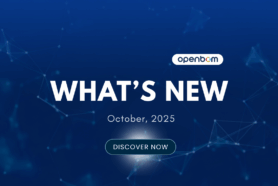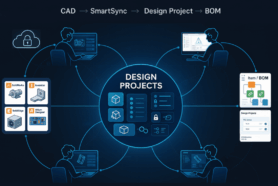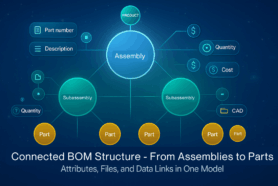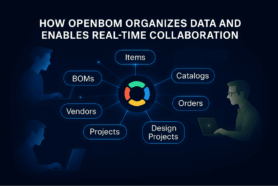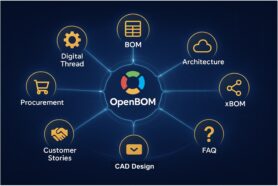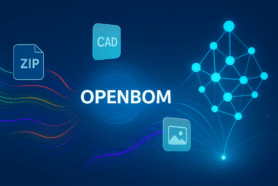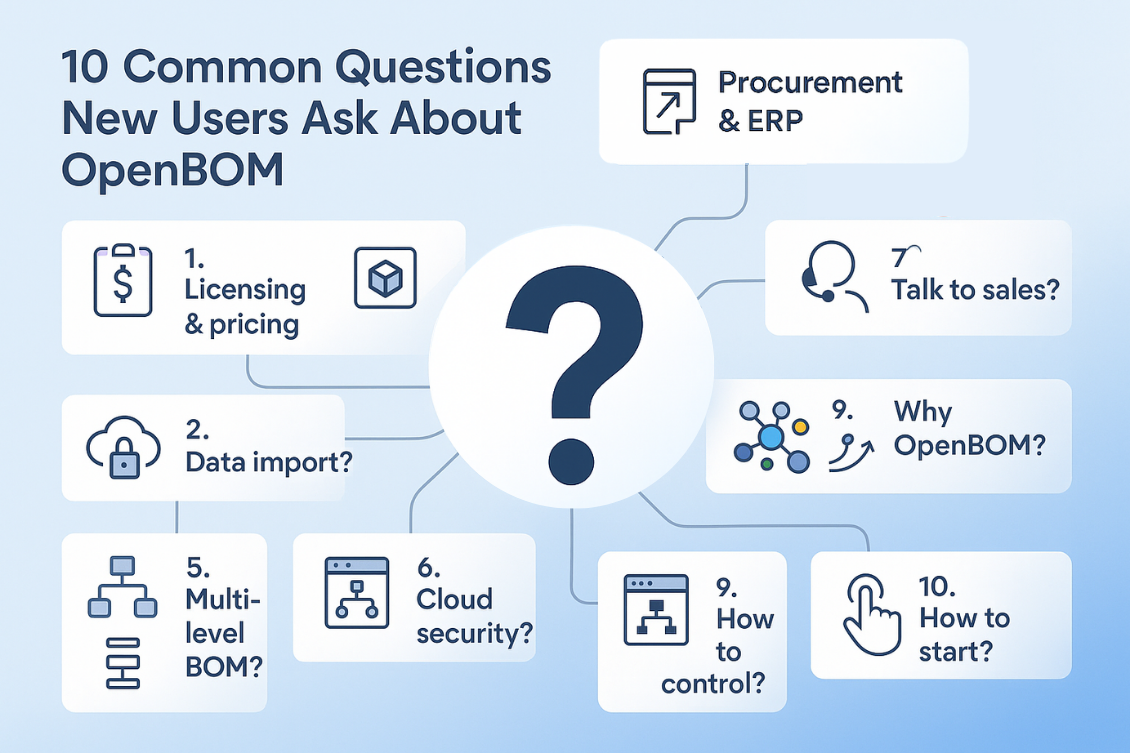
Welcome back to my 30-Day OpenBOM Blogging Journey!
Earlier, I explored how OpenBOM connects engineering, manufacturing, and procurement through modern data models like xBOM and multi-tenant cloud architecture. Today’s post is more practical—it’s for everyone discovering OpenBOM for the first time.
If you’ve just started your free trial, joined a demo, or are exploring whether OpenBOM can replace your spreadsheets or legacy systems, you probably have the same questions I hear every day from new users.
So, here they are: 10 of the most common questions newcomers ask—and the answers that will help you understand what OpenBOM is, how it works, and why it’s different.
Q1. What is OpenBOM’s licensing and pricing model?
OpenBOM uses a seat-based SaaS (Software as a Service) model. You subscribe to the number of seats you need, and each seat gives a user secure cloud access to the full OpenBOM environment—anytime, anywhere.
There are multiple subscription tiers (different by the number of features):
- Individual and Team plans – for designers and engineers who need to manage BOMs, catalogs, and CAD integrations collaboratively.
- Company and Enterprise plans – for growing organizations that require integrations, data governance, and company-wide collaboration.
- OpenBOM also provide a read-only seats allowing to the user only view information with no changes)
A free non-commercial plan is available for hobbyists and personal projects, and every business user can start with a 14-day free trial—no credit card required.
At the Enterprise level, OpenBOM offers full flexibility:
- Out-of-the-box ERP, PDM, and PLM integrations
- Custom integration development through OpenBOM APIs
- Enterprise onboarding and support
- Advanced configuration options for large deployments
More details can be found at openbom.com/pricing.
Q2. What CAD tools does OpenBOM integrate with?
OpenBOM integrates with nearly every leading CAD system, either natively or via custom connectors.
Native, production-ready integrations include:
- Dassault Systemes SOLIDWORKS
- Autodesk Fusion
- PTC Onshape
- Altium Designer
- PTC Creo
- Autodesk Inventor
- Solid Edge
We are continuously developing new integrations, so please tell us what integration you need.
All official integrations are developed and maintained directly by OpenBOM, ensuring deep feature support and reliable performance.
For other CAD or PLM systems, OpenBOM provides API-based and MCP Server integrations, allowing data to flow seamlessly into the OpenBOM workspace.
The result is an automated link between design and business—your BOMs, catalogs, and item metadata are updated directly from CAD, eliminating manual export and reentry errors.
(See Day 5 for how OpenBOM bridges CAD and procurement.)
Q3. How does OpenBOM handle data import from legacy PDM or Excel?
Most new users start with data scattered across Excel, network drives, or old PDM systems—and OpenBOM was designed to make that transition painless.
Its flexible graph based data model lets you import virtually any structure of product information without heavy setup or rigid templates.
You can bring in data using several methods:
- Excel or CSV import for catalogs, BOMs, and vendor lists.
- ZIP importer to upload entire datasets, including images, PDFs, or specs.
- SmartSync to automatically sync local CAD directories and design data with the cloud.
- REST API for automated or large-scale migrations from PDM/ERP.
Within minutes, legacy spreadsheets become structured, linkable data in OpenBOM’s graph-based product memory, ready to connect to designs, suppliers, and procurement workflows.
Q4. How secure is my cloud data?
Security is built into OpenBOM from the ground up.
The platform runs on Amazon Web Services (AWS)—the industry leader in physical data-center security, redundancy, and reliability.
At the application level, OpenBOM employs:
- Multi-tenant isolation so each company’s data is securely partitioned.
- Encrypted communication and storage
- Multi-factor authentication (MFA) for user access.
- SOC 2 Type II compliance for operational and data-handling controls.
Unlike traditional on-premise systems, you don’t manage servers or patches; you simply log in and work securely from anywhere.
Cloud security isn’t just safer—it’s also faster and always up to date.
Q5. Can I manage multiple BOMs—EBOM, MBOM, and Service BOM—together?
Yes. That’s one of OpenBOM’s core capabilities.
With its xBOM architecture, OpenBOM lets you model all BOM perspectives—Engineering (EBOM), Manufacturing (MBOM), Service, and Maintenance—in a single system without duplicating data.
Each part, assembly, and subsystem is represented once in the graph and can appear in multiple BOM views. Engineers, manufacturing planners, and service teams can each see the data relevant to their workflow while referencing the same underlying digital thread.
This approach eliminates the version chaos of multiple spreadsheets and keeps all disciplines aligned across the product lifecycle.
(See Day 4: From PDM to xBOM – The New Product Structure Model for a deeper dive.)
Q6. Does OpenBOM replace PDM, does it do check-in/out for files? What about PLM functions such as revision control, change management,?
OpenBOM delivers a modern, cloud-native PDM service through its Design Projects capability—a powerful module that combines file management, revision control, and collaborative workflows.
With Design Projects you can:
- Manage CAD files in the cloud directly linked to BOMs, items, and catalogs.
- Use check-in/check-out workflows to maintain control over design ownership.
- Track revisions and versions automatically for parts, assemblies, and documents.
- Apply cloud-based collaborative locking, so multiple users never overwrite each other’s work.
- Store an unlimited number of files (CAD, drawings, PDFs, images, etc.) with full traceability.
Beyond file management, OpenBOM introduces a full revision and change-management framework. Every item or BOM in the system can have controlled revisions connected to Engineering Change Orders (ECOs) and approval workflows.
This means you can:
- Create and track ECOs directly inside OpenBOM.
- Define approval steps and responsible roles (engineer, reviewer, manager).
- Maintain a complete audit trail of every change—what changed, who approved it, and when.
This level of visibility helps companies maintain compliance and ensure that released designs are properly reviewed before manufacturing.
For teams already using traditional PDM systems such as SolidWorks PDM or Autodesk Vault, OpenBOM can complement those environments by connecting CAD vaults to downstream business processes—BOMs, suppliers, and procurement data.
However, for many small and mid-sized manufacturers, OpenBOM’s integrated PDM is an ideal replacement. It’s faster to deploy, easier to maintain, and offers full transparency across design and business data—without servers, VPNs, or IT overhead.
In short, OpenBOM combines the discipline of classic PDM with the agility of modern cloud collaboration, uniting design control, change management, and lifecycle traceability in one workspace.
Q7. How does OpenBOM support procurement? Does it manage inventories and replaces ERP?
OpenBOM includes integrated inventory control and purchasing management features that extend the digital thread from engineering all the way to procurement.
You can:
- Aggregate quantity roll-ups from multiple BOMs.
- Track parts, stock levels, and suppliers.
- Generate purchase orders directly within OpenBOM.
- Assign costs and perform sourcing analysis.
For smaller companies, these capabilities can handle end-to-end purchasing without needing an ERP system.
For organizations that already run ERP or MRP, OpenBOM integrates with leading solutions like QuickBooks, Xero, Odoo, NetSuite, Microsoft Dynamics 365, Priority, and others—out of the box or via custom API services.
This flexibility means OpenBOM can either serve as your lightweight ERP layer or connect seamlessly to your existing financial and production systems.
(See Day 5: How OpenBOM Bridges CAD, BOM, and Procurement in One Workspace for real-world examples.)
Q8. Can I talk to Sales to understand if OpenBOM is right for my company?
Yes—OpenBOM’s team is always available to help you evaluate whether the platform fits your needs.
The easiest way to connect is to schedule a demo directly from the website. Click “Schedule a Demo,” pick a convenient time, and one of our product experts will walk you through:
- How OpenBOM aligns with your current workflows.
- Which integrations make sense for your setup.
- Pricing options and best-practice onboarding steps.
Visit openbom.com to book a meeting and start your discovery call today.
Q9. What makes OpenBOM different from other ERP or PLM vendors?
OpenBOM was built for a different era of manufacturing—where speed, collaboration, and openness matter more than heavy enterprise infrastructure.
Here’s what makes OpenBOM stand apart:
- Multi-tenant architecture: Every customer runs on the same continuously updated cloud platform—no servers, no upgrades.
- Graph-based data model: Relationships between parts, assemblies, and documents form a living product graph, not static tables.
- Openness: REST APIs allow easy integrations with CAD, ERP, and business systems.
- AI-ready foundation: The upcoming OpenBOM.AI layer and MCP Server enable intelligent assistance, natural-language queries, and agentic workflows.
- Ease of adoption: You can register and start working in under a minute.
In short, OpenBOM delivers the depth of PLM with the simplicity and flexibility of a collaborative SaaS workspace.
Q10. How can I start a trial and get onboarding help?
Getting started takes just a few minutes:
- Go to www.openbom.com and start your free 14-day trial.
- Connect your CAD tool or import your Excel BOM.
- Explore onboarding videos and tutorials in the OpenBOM Learning Center.
- Use the AI Support Agent at help.openbom.com for real-time guidance.
- Join a live demo session to see practical use cases.
You’ll be able to create your first connected BOM and experience how OpenBOM brings engineering, manufacturing, and procurement together in one collaborative workspace.
Conclusion – The “Open” in OpenBOM
At OpenBOM, we believe openness is more than a name—it’s a philosophy.
We design our platform to be transparent, extensible, and accessible to every manufacturing company, no matter the size. By combining multi-tenant cloud infrastructure, flexible data modeling, and a growing AI foundation, OpenBOM helps teams build a digital thread that truly works for people.
If you’re still managing product data through spreadsheets, file vaults, or disconnected systems, OpenBOM offers a clean, modern alternative.
👉 REGISTER FOR FREE today and see how fast you can connect design, data, and decision-making in one platform.
Stay tuned for Day 8, where we’ll explore how real-time collaboration transforms the way distributed teams work together.
Best, Oleg
Join our newsletter to receive a weekly portion of news, articles, and tips about OpenBOM and our community.

